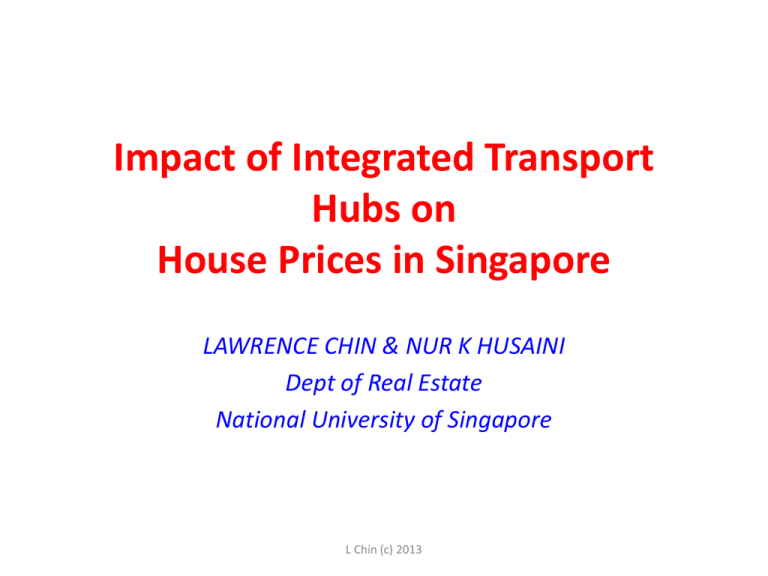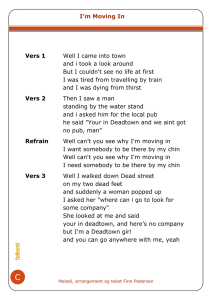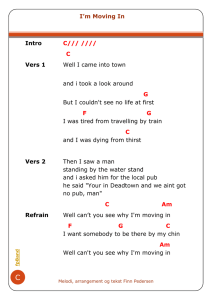Adaptive Reuse in Singapore: Balancing Conservation Needs and
advertisement

Impact of Integrated Transport Hubs on House Prices in Singapore LAWRENCE CHIN & NUR K HUSAINI Dept of Real Estate National University of Singapore L Chin (c) 2013 Outline • • • • • • Introduction Objectives of paper Literature review Research method Findings of study Conclusion L Chin (c) 2013 SINGAPORE: Size and Skyline L Chin (c) 2013 New skyline of Singapore L Chin (c) 2012 Constraint #1: Scarcity of land ultimate land area of 730 sq km L Chin (c) 2012 Constraint #2: Competing uses for land L Chin (c) 2012 Planning for Accessibility L Chin (c) 2012 Introduction • Residential property is a commodity of variable uses, equipped with unique characteristics attributable to internal and external factors, each playing a major role in determining its inherent value. • Improvements in accessibility and enhancing the ease of commuting would inflate property prices beyond the usual due to positive externalities generated. • Additionally, transportation networks attract multitudinous types of activities such as retail and F&B to the area, further escalating prices of properties located nearby the bustling node. • In the case of Singapore, the concept of Integrated Transport Hubs (ITHs) under in the 2008 Land Transport Review, which integrates a Mass Rapid Transit (MRT) station, an air-conditioned bus interchange and a string of lifestyle shops for added convenience and shelter from the atmospheric conditions. L Chin (c) 2013 Objectives of Paper • To examine the effects of an Integrated Transport Hub (ITH) presence on the prices of public residential property. • To apply case study of the Bukit Panjang Transport Hub, comparing the differences in HDB Resale prices between units located in the influence and the control areas. L Chin (c) 2013 Why this research? • The purpose is to investigate the price increment of residential properties caused by the presence of an ITH; thereafter serving as an extension to existing literature where the price effects on high rise residential property due to the construction of a transport hub is currently absent or lacking. • A study in the recent past analyzed price changes on residential property price due to improved infrastructure (Lum, Koh, & Ong, 2004) and other studies have explored the impact of MRT on residential property prices(Bajic, 1983; Grass, 1992; Ong, 2001) L Chin (c) 2013 Hypothesis to be tested • That Transport Hubs would generate a housing premium on units located in the influence areas, using walking distance to distinguish between units located near to or away from the Transport Hub. • To determine the impact of the transport on the neighbouring residential properties using hedonic regression model L Chin (c) 2013 Literature Review • Real estate is an immovable property; thereafter making it susceptible to changes in its immediate surroundings. • Alteration of its nearby environment will undoubtedly impact the real estate price. • Hence, it is common to witness fluctuations in real estate price caused not only by the economic environment, but also by the physical environment surrounding the real estate; specifically in this case, the presence of a transport hub close by. L Chin (c) 2013 Location Theories • Location theories were developed by early economists to explain the pattern of land use by providing solutions to the problems associated with the optimal use of the land. • Pricing mechanisms would dictate the utility of good and services supplied in an urban area, which ultimately leads to locations of activity followed by the development of spatial structures in the urban area. • It would be difficult to assign one location theory to be applied generally depending on the land use (industrial or commercial) of a plot of land. • Factors such as technology and transportation, changes in population, government redevelopment of the built environment and policies, as well as similar land uses, which exist within the same area, would complicate the decision-making process about optimal locations. L Chin (c) 2013 • William Alonso (Alonso, 1975) was the first to successfully theorise, following the works of(Isard, 1956), and Wingo (1961), the relationship between the urban spatial structure and the location of firms and households in the field of Urban Economics in 1964, having expanded Johann Heinrich von Thunen’s Land Rent Theory (Thunen, 1966). • The latter had postulated that ‘central’ towns are able to fetch high rents due to high demand and limited supply of the land, supported by savings in transport costs. L Chin (c) 2013 • The willingness for a consumer to pay for housing is dependent on how much importance they place on individual attributes (Kain & Quigley, 1970; Wilkinson, 1973). • Consequently, the differences in preferences stem from varying household size, income, aspiration level and the demographic make-up of the household (Wilkinson, 1973; Gorter & Nijkamp, 2001). • Thus the main influences of land rent or prices and location decision are based upon the firm’s or household’s preferences, restrictions on budgets, frequency and convenience of available transportations, and transport costs (So, Tse, & Ganesan, 1997). L Chin (c) 2013 Transit-oriented Developments (TOD) • The effect on property prices by rail transportation has been researched by a number of researchers from different viewpoints and perspectives, which includes analyses from a variety of transport system types, such as light rail, mass rapid and buses, of the residential or commercial impacts by transport and even the causal relationships which cause the positive or negative effects (Brinckerhoff, 2001). • The results from these various studies have produced mixed results, causing researchers to continue examining the issue. L Chin (c) 2013 Impact on Property Values • In most of these studies, a positive relationship was discovered between housing prices and proximity to rail stations (Grass, 1992; Nelson, 1999; Almeida & Hess, 2007; Chen, Rufolo, & Dueker, 1997; Haider & Miller, 2000). • In addition, there is hardly evidence that proximity to rail transit would depress housing prices, unless in the presence of influential variables outside of transit station proximity (Bowes & Ihlanfeldt, 2001). L Chin (c) 2013 Proxy for Proximity Measurement • In measuring the threshold for walking distance and time by commuters towards LRT stations, it was proven that in Calgary, Canada, the average walking distance to LRT stations in suburban locations was 649m and in Central Business District (CBD) areas, 329m (O'Sullivan & Morall, 1996). • Thus on average, pedestrians were willing to travel 400m or about 5 minutes to the LRT. Guidelines used in Canada and North America for average walking distances indicate 300 to 900 metres and 400 to 800 metres respectively. L Chin (c) 2013 Sources of Data • Residential housing prices between influence and control areas are compared to obtain the housing price premium attributable to the presence of a transport hub • Resale transactions from 15th July 2008 were collected from Streetsine, a database for real estate agents and investors, and brought forward to 2012 prices using the HDB Resale Price Index. • A total of 524 public housing resale transactions were collected from data sources for the study areas from 15th July 2008 till present (February 2012). • This large time frame was essential to provide capture sufficient housing transactions since the announcement of the transport hub creation in order to arrive at a sample size which would allow for a normal distribution. L Chin (c) 2013 Methodology • A controlled experiment was done to compare the differences in housing prices to show the impact the transport hub has on the housing units. • Hence, two separate data sets were collected namely from the influence group and the 3 control groups, which can be categorized as follows: • Influence Group: HDB resale units which fall within 500 metres walking distance from Bukit Panjang ITH • Control Groups: HDB resale units which are more than 500 metres walking distance from Bukit Panjang ITH (Senja LRT, Petir LRT) L Chin (c) 2013 Model Specification • Used extensively in the housing economic analysis, hedonic analysis statistically unbundles these different attributes and estimates their separate value (Cortright, 2009). • More specifically, the analysis determines several regression coefficients that measure, at the margin, each respective characteristic’s independent effect on property value (Fuguitt & Wilcox, 1999). L Chin (c) 2013 Figure 1. Overview of Bukit Panjang ITH, Influence and Control Areas L Chin (c) 2013 Equation • Thus, the hedonic model is represented using the log-log form in the equation below: • (LnPricei,y) = β0,y +β1,y (LnAgei,y) +β2,y (Leveli,y) +β3,y (LnAreai,y) +β4,y(Proximity to Transport Hub,y) +εi,y Where (LnPricei,y) = Transacted price for property i in year y, (LnAgei,y) = Age of property i in year y (Leveli,y) = Level (in strata of 5) of property i in year y (LnAreai,y) = Size of property i in year y (Walking Distancei,y) = Walking distance to Transport Hub εi,y = Error term L Chin (c) 2013 Independent Variables • The independent variables in the study include age, floor level, floor area or size of unit and walking distance. Further explanations are provided for below. • Age • The age of a housing unit is the determinant of housing price. Both have a negative relationship which arises due to deterioration of building quality and structures. Usually, this is called the depreciation factor of buildings. • Floor Level • It is well established that higher floors would command greater premium due to factors like better view and air circulation. However, as HDB as well as the database used only provided for categories of data level i.e. stratum of 5, the strata are grouped according to height where 1,2,4,5 corresponded to Level 1 to 5, Level 6 to 10, Level 11 to 15, Level 16 to 20 and Level 20 to 25 respectively. L Chin (c) 2013 Independent Variables • • • • • • Floor Area Area forms the basis of calculating housing prices. In most cases, ceteris paribus, a bigger floor area would generate a higher housing price. Area per square feet (psf) housing has an inverse relationship with housing price as a larger unit would generally tend to have a lower price psf as compared to a smaller unit, even though overall, the larger unit has a higher price. Proximity to Transport Hub The proximity to the transport hub is categorized as a dummy variable. Units in the control area are categorized as being more than 500 metres from the transport hub hence are represented by “0” to indicate insignificant influence by the transport hub. Units in the influence area, contrastingly, are categorized as “1” to indicate the influence of a transport hub. HDB Resale Price Index (RPI) The RPI tracks the overall price movement of the public residential market. Using the 4th quarter of 1998 as the base period, resale transactions regardless of location, flat types and models, can be calculated. In the study, the RPI was utilized in order to compare past transactions to today’s prices. L Chin (c) 2013 Results • The basic functional form of multiple linear regression adopted in this study is the log-log function due to statistical significance of the explanatory variables, employing the Ordinary Least Squares (OLS) method which estimates the "best fit" of a set of independent (X) variables against the dependent variable (Y) variable which is to be predicted. • Most importantly, all the explanatory variables displayed coefficients which were statistically significant with p-values of zero. • Additionally, all the equations proved that floor area is the explanatory variable that has the strongest impact on housing price with a t-statistic of 24.532 (log-log). • Subsequently, floor level followed by proximity to the transport hub are the second and third most important factors influencing housing prices. L Chin (c) 2013 Summary of Key Findings • After generating the regression results from the OLS method, the results showed that a 12.6% premium was commanded for housing units located within the influence area which is located at most 500 metres from the Bukit Panjang ITH. • Other independent variables that were accounted for other than proximity to the transport hub were area of the units, age of the units and the level of the units, which were classified in strata of 5. • Results showed that area of the units was the most important factor determining house price, followed by level and then proximity to the transport hub. • It was also discovered that all the explanatory variables utilized in the study were highly significant in predicting house price. L Chin (c) 2013 • Furthermore, the results of the study are consistent with the previous studies which indicated that proximity to a transport hub would generate a higher premium for housing units located in influence areas. • With this knowledge, locations near a transport hub would bode well with high-density housing as compared to areas located further away. • On top of that, it shows that walkability to a transport hub is priced. L Chin (c) 2013 Significance of Study • The findings will contribute to the field by understanding the ultimate value (positive or negative) the construction of the transport hub will bring to the residential properties in the area. • In land tenders, developers can use this insight in submitting bids. • This would supply valuable insights into the determinants of varying property prices across the different regional hubs. L Chin (c) 2013 THANK YOU! L Chin (c) 2013








